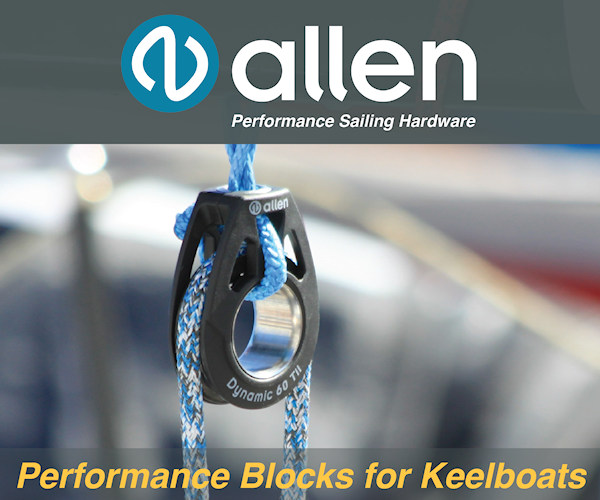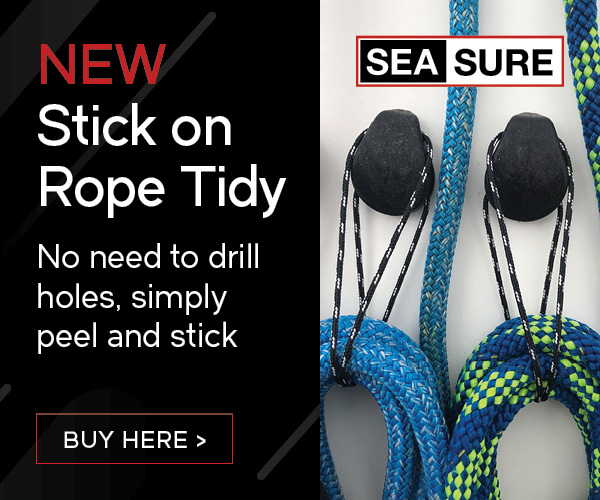






-(1)-202408140552.gif)





Boats for sale
| Laser 161752 Tynemouth |
 |
| Laser 140101 Tynemouth |
 |
| Laser 28 - Excellent example of this great design Hamble le rice |
 |
List classes of boat for sale |
Slipping Main Halyard |
Post Reply 
|
Page 123> |
| Author | |
NickA 
Really should get out more 
Joined: 30 Mar 05 Location: United Kingdom Online Status: Offline Posts: 784 |
 Post Options Post Options
 Quote Quote  Reply Reply
 Topic: Slipping Main Halyard Topic: Slipping Main HalyardPosted: 19 Apr 15 at 7:09pm |
|
I have some nice new sails which are stiff as stiff. Whenever I put the kicker or cunningham on, the sail drops down the mast a bit. Between races we're hoiking the main sail back up the mast. It's not a new halyard, so I doubt it's stretching; so must be the halyard slipping in the cleat.
I could use stickier halyard rope perhaps (recommendations?) and/or get a sharp new V-Cleat (to eat away the new rope). But there must be some better way than friction to hold up the main (yes I know, halyard lock; sadly it's complicated and likely not class legal). I have seen a few boats with a dyneema halyard with a loop on the end that slips over a "toothed rack" at the mast foot; this seems a really good idea, but hardly anyone uses it. What's the drawback? Anyone know?
|
|
|
Javelin 558
Contender 2574 |
|
 |
|
NHRC 
Posting king 
Joined: 13 Dec 13 Location: Lymington Online Status: Offline Posts: 102 |
 Post Options Post Options
 Quote Quote  Reply Reply
 Posted: 19 Apr 15 at 7:52pm Posted: 19 Apr 15 at 7:52pm |
|
Halyard locks are very simple... Great addition.
Your clear is most likely your biggest issue with your current system. |
|
 |
|
FreshScum 
Groupie 
Joined: 27 Apr 04 Online Status: Offline Posts: 99 |
 Post Options Post Options
 Quote Quote  Reply Reply
 Posted: 19 Apr 15 at 7:56pm Posted: 19 Apr 15 at 7:56pm |
|
The other thing that could be happening that only halyard locks can prevent is that your mast is bending when kicker/cunningham is applied.
This means that the main will fall and inch, give or take, when these controls are applied and there is nothing you can do about it. A good halyard in a good cleat does not slip enough to be a problem. If you make sure that your halyard is longer than it needs to be, then you can regularly move where the halyard is being cleated, lengthening the effective life of the halyard.
|
|
 |
|
Paramedic 
Really should get out more 
Joined: 27 Jan 06 Location: United Kingdom Online Status: Offline Posts: 929 |
 Post Options Post Options
 Quote Quote  Reply Reply
 Posted: 19 Apr 15 at 7:56pm Posted: 19 Apr 15 at 7:56pm |
|
There isn't really a drawback, it works quite well like that. 2:1 halyard is the other option. The rack is a wear point, but dyneema is pretty good from the wear point of view.
Halyard locks are great when they work, a total liability when they dont! :)
|
|
 |
|
Lukepiewalker 
Really should get out more 

Joined: 24 May 06 Location: United Kingdom Online Status: Offline Posts: 1341 |
 Post Options Post Options
 Quote Quote  Reply Reply
 Posted: 19 Apr 15 at 10:01pm Posted: 19 Apr 15 at 10:01pm |
|
Disadvantage of a hook rack is the knot for the loop weakening the rope (most of us have plenty of strength in reserve though, so not really an issue). The knot for the loop needs to be able to pass through any holes in the mast for an internal halyard and/or allow enough travel so you can detach it, you don't want it getting jammed in the sheave at the top of the mast (it might be able to pass through the sheave easily, in which case you're ok).
Of course they offer pretty good repeatability, once the braid of the rope and the knots have settled, you know you are putting it in the same place every time. |
|
|
Ex-Finn GBR533 "Pie Hard"
Ex-National 12 3253 "Seawitch" Ex-National 12 2961 "Curved Air" Ex-Mirror 59096 "Voodoo Chile" |
|
 |
|
craiggo 
Really should get out more 

Joined: 01 Apr 04 Location: United Kingdom Online Status: Offline Posts: 1810 |
 Post Options Post Options
 Quote Quote  Reply Reply
 Posted: 19 Apr 15 at 10:09pm Posted: 19 Apr 15 at 10:09pm |
|
No need for knots, just splice the loop and splice the tail onto it. Worked really well on the 49er. The problem with cleats is that they tend to wear from pulling the sail up with the halyard running through the cleat, also there is always a bit of creep as the rope binds between the jaws.
|
|
 |
|
NickA 
Really should get out more 
Joined: 30 Mar 05 Location: United Kingdom Online Status: Offline Posts: 784 |
 Post Options Post Options
 Quote Quote  Reply Reply
 Posted: 19 Apr 15 at 10:54pm Posted: 19 Apr 15 at 10:54pm |
|
Like craigo says, was my plan. Nice strong H
Bummel lock splice with a mousing line through it to pull it down to the rack. PS don't mind the sail coming down a bit when the Cunningham goes on ... So long as it goes back up again without me hauling on the halyard.☺ |
|
 |
|
Lukepiewalker 
Really should get out more 

Joined: 24 May 06 Location: United Kingdom Online Status: Offline Posts: 1341 |
 Post Options Post Options
 Quote Quote  Reply Reply
 Posted: 19 Apr 15 at 11:07pm Posted: 19 Apr 15 at 11:07pm |
|
Indeed, that is the plaster man if your rope construction allows it. Originally most of them had a wire halyard with a rope tail (this was usually spliced 3 strand rope, I think it was a rule or something...), the rope was always slightly too big to fit through the hole in the mast without some wrestling, and being not particularly robust would slowly get sawn through by the halyard.
|
|
|
Ex-Finn GBR533 "Pie Hard"
Ex-National 12 3253 "Seawitch" Ex-National 12 2961 "Curved Air" Ex-Mirror 59096 "Voodoo Chile" |
|
 |
|
gordon1277 
Really should get out more 
Joined: 24 Mar 10 Location: United Kingdom Online Status: Offline Posts: 665 |
 Post Options Post Options
 Quote Quote  Reply Reply
 Posted: 20 Apr 15 at 8:35am Posted: 20 Apr 15 at 8:35am |
|
Hi
I had this issue last year after replacing the rope. I think the new rope just kills and old cleat so replace the cleat and you should be fine. My old boat had a wire halyard and rack, worked really well. Good luck. Gordon |
|
|
Gordon
Lossc |
|
 |
|
JohnJack 
Far too distracted from work 
Joined: 12 Mar 13 Online Status: Offline Posts: 246 |
 Post Options Post Options
 Quote Quote  Reply Reply
 Posted: 20 Apr 15 at 9:00am Posted: 20 Apr 15 at 9:00am |
|
We have had this problem on the Scorpion (which is probably the first boat I have sailed that has a single camcleat/v-jammer holding the halliard
We haul the sail up and find the point at where the halliard sits in the cleat. We then put a small loop in the halliard at this point (one that will 'slip' out easily). We then thread the tail of the halliard through this to give us a 2:1 (there is a halliard block under the cleat) and pull the knot down so that when cleat the knot sits up against the lower face of the cleat with the halliard in the cleat. Not sure how clear that is?? Maybe a picture would be best. However it works very well the main cant budge (we used a D-12 Halliard) |
|
 |
|
Post Reply 
|
Page 123> |
| Forum Jump | Forum Permissions  You cannot post new topics in this forum You cannot reply to topics in this forum You cannot delete your posts in this forum You cannot edit your posts in this forum You cannot create polls in this forum You cannot vote in polls in this forum |
Bulletin Board Software by Web Wiz Forums® version 9.665y
Copyright ©2001-2010 Web Wiz
Change your personal settings, or read our privacy policy
Copyright ©2001-2010 Web Wiz
Change your personal settings, or read our privacy policy











 Printable Version
Printable Version Delicious
Delicious Digg
Digg Facebook
Facebook Furl
Furl Google
Google MySpace
MySpace Newsvine
Newsvine reddit
reddit StumbleUpon
StumbleUpon Twitter
Twitter Windows Live
Windows Live Yahoo Bookmarks
Yahoo Bookmarks Topic Options
Topic Options